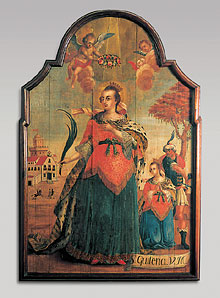
Anonymous, Virgin Martyr Saint Quiteria, 18th century. Tempera on wood, 248 x 166 cm. Arquidiocese de Olinda e Recife, Convento de Santo Antônio, Pinacoteca de Igarassu. Photo by Breno Laprovitera.

Brazil: Body and Soul includes a small but extremely important selection of eighteenth-century works on panel. Among the most unusual are two paintings from a four-part series painted for the church of São Cosme e São Damião in the town of Igarassu, Pernambuco (now in the convent of Santo Antônio in the same town). By an anonymous painter working in 1729, they are highly evocative images, representing: The Arrival of the Portuguese and Their Triumph over the Igarassu Indians in 1532 and The Miracle that Spared the Town of Igarassu from the Plague. These paintings display strong narrative qualities that engage the viewer, who becomes a participant in the protocinematic running narrative.
Brazil: Body and Soul also includes two panels from Recife that depict the miracles of the life of Saint Benedito, one of Brazil’s many black saints. One panel depicts the saint praying in the company of other monks, while the other is a tender image of the Virgin and Child appearing to the saint. There are also panels depicting scenes from the martyrdom of Saint Quiteria and the life of Saint Francis.
Secular painting in the Brazilian Baroque is relatively rare. While some portraits survive, there are few depictions of everyday life or historical scenes. Two paintings on canvas dated circa 1789 offer extraordinarily important information about many aspects of quotidian life in late-eighteenth-century Rio de Janeiro, including dress, means of transportation, and construction practices: Fire at the Retreat of Nosso Senhora do Parto and Reconstruction of the Retreat of Nosso Senhora do Parto by João Francisco Muzzi. The retreat was an asylum or reformatory for women who were confined there at the wishes of their husbands or fathers. It burned in late-August 1798 and was quickly reconstructed according to plans devised by the sculptor and architect Mestre Valentim. In Reconstruction, we see a portrait of the Afro-Brazilian architect showing his plans to the Viceroy Dom Luis de Vasconcelos. The exhibition also includes the four-part Allegory of the Four Continents by the eighteenth-century Afro-Brazilian master José Theóphilo de Jesus.
—Edward J. Sullivan